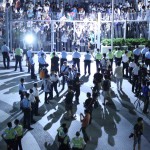Rocco Yim, the designer of the government complex and the Tamar Project, was one of the speakers in Roskam’s public forum. Yim said his project was intended to create an open space for public engagement, and Tamar was designed to accommodate public gatherings, including protests. His “door always open” design for the complex symbolises openness.
Yim told the Wall Street Journal he was disappointed to see the construction of a three-metre high fence at the East Wing Forecourt of the CGO, and hoped it would not be permanent.
The East Wing Forecourt of the CGO became known as “Civic Square” during the Anti-National Education movement in 2012. Since then, it has been at the heart of different large-scale protests and many people look upon it as an open space for public gatherings.
However, in July last year, the Administration Wing of the Chief Secretary for Administration’s Office suddenly closed the East Wing Forecourt and erected a perimeter fence. It later reopened but with new restrictions barring the public from the area between 11 p.m. and 6 a.m., and only allowing protests to be held there on public holidays and Sundays with consent from the CGO management.

The space became the centre of attention once more on the evening of September 26 last year. As a week-long class boycott to demand open elections for the Chief Executive in 2017 drew to a close, more than a hundred demonstrators broke through the fence to “reclaim Civic Square” as a public space and show their support for democracy.
Among them was Jasmine Choi Yan-yan, a 22-year-old student of the Chinese University of Hong Kong, who was arrested on September 27. Choi says she had never intended to charge into the square – which led to the premature launch of the Occupy Movement – but she has no regrets. “[It was] originally a space that belongs to us,” she says.
Choi thinks people have the right to demonstrate in public spaces and that Civic Square should be accessible to citizens. “It is ridiculous that we need to get permission to assemble from the government that we are protesting against! Will the authoritarian government eventually prohibit us from protesting?” she says.
Choi thinks it is not only people’s rights in public spaces that have been undermined, but also their rights to assembly, which are determined by the Public Order Ordinance.
The current version of the Public Order Ordinance came into effect after the handover in 1997. It grants the government the authority to prohibit public assembly on a number of grounds, including national security and public order. Under the ordinance, citizens have to apply for a notice of no objection from the Commissioner of Police before more than 30 people can assemble in a public space.
The vice-chairman of the League of Social Democrats, Raphael Wong Ho-ming, also sees the Public Order Ordinance as a major impediment to Hongkongers trying to exercise their rights. “It requires you to apply for an approval from the police in any kind of protest,” he points out, “so even if you have public spaces, your right of protest is still constrained.”
Wong suggests that the ordinance should remove the requirement to apply for a no-objection notice a week in advance, and that communication between the government and the public should be free from restrictions. “How can you express your ideas with lots of metal and barricades in the area?” he questions.
Wong was charged, along with 77 others, with Forcible Entry and Unlawful Assembly under the Public Order Ordinance after breaking into Civic Square. He argues the charge cannot stand as Civic Square is a public area. What is more, he says the Administration Wing has violated their previous written undertaking that “when the works on the perimeter fence are completed, members of the public visiting CGO or the Legislative Council daily will not be affected and they will still have access to the East Wing Forecourt as usual”.
Access to the square is currently the subject of an application for a judicial review launched by Cheung Tak-wing, a photojournalist who was also arrested on September 27 in Civic Square
Representing Cheung, the Democratic Party’s Albert Ho Chun-yan argues Civic Square has long been a platform for the government and the public to communicate. “In the past three years, the officials always received petitions from the public in that area, and people are used to assembling and protesting there,” he stresses, “so the expectation of it being a public space is not coming from nowhere.”
Ho says the application has been accepted and he has invited senior counsel Gladys Li to take charge of the forthcoming legal procedure.
While the arguments over the definition of public space and the status of Civic Square continue, the Town Planning Board stated in documents from 2013 that: “The site in front of the G/IC (4) sub-area, being the East Wing Forecourt of the CGO, is an open-air civic square and public open space. It provides a popular gathering ground for civic functions and general recreational activities.”Yet, Carrie Lam Cheng Yuet-ngor, the Chief Secretary for Administration, says the forecourt is not part of the public open space mentioned in the planning permission, but simply an open area used as a vehicular access for the CGO. Lam says it is a government property and the decision to erect the fences was made to enhance security around the CGO.






































